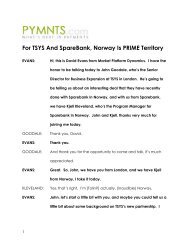Lydian Payments Journal - PYMNTS.com
Lydian Payments Journal - PYMNTS.com
Lydian Payments Journal - PYMNTS.com
Create successful ePaper yourself
Turn your PDF publications into a flip-book with our unique Google optimized e-Paper software.
gravitate towards these themes. For example, historically innovation in the <strong>com</strong>puter industry focused on<br />
increasing core product improvements (i.e., processing power, memory, lighter laptops, flat screens, CD<br />
and portable memories instead of floppy disks, wireless capacity, etc.). In contrast, if the leading firms have<br />
grown in profit and size by producing deceptive signals that suggest low prices while actually charging<br />
higher prices, this strategic philosophy will be<strong>com</strong>e just as deeply ingrained and can be<strong>com</strong>e selfperpetuating.<br />
For example, in the mortgage industry preceding the financial crisis, deceptive pricing<br />
practices grew in prevalence and were reflected in product features such as “exploding” adjustable rate<br />
mortgages with large built‐in price increases.<br />
For all of these reasons, markets that have peacock‐market‐tendencies will likely tend to be<strong>com</strong>e more and<br />
more differentiated into predominantly peacock markets over time.<br />
A Field Guide to Spotting Peacocks<br />
Since some level of distortion may occur in many markets, it is important to have applied indicators that<br />
differentiate a peacock market from other markets. Signs of a peacock market include:<br />
• Signals are no longer strongly correlated to their underlying intended purpose. Often in<br />
traditional signaling theory, an intended signal is ac<strong>com</strong>panied by random distortion. 4 However, in<br />
a peacock market the distortion is intentional. In fact, a price signal may yield little information<br />
about the overall price and may even be inversely correlated with it.<br />
• Increasing disparity over time between the signaled information and the underlying factor it<br />
is intended to represent. A peacock market is an evolving market. Therefore, over time, the<br />
signals may get further and further removed from the information they are intended to signal. For<br />
example, there may be growth in the disparity between the average signal price and non‐signal<br />
price over an extended period.<br />
• The signal <strong>com</strong>es to dominate and drive product design. Signals in peacock markets are no<br />
longer merely marketing to enhance a core product, but be<strong>com</strong>e the primary driver of demand and<br />
profitability. Therefore, products evolve to be designed around the signal. This is a clear sign of<br />
market inefficiency since innovation is no longer focused on making fundamentally better products.<br />
• The evolution of “fragmentation.” Fragmentation occurs when firms intentionally break price or<br />
quality into smaller pieces for the purpose of creating signals. The traditional economic literature<br />
4 See, e.g., A. Michael Spence, “Signaling in Retrospect and the Informational Structure of Markets,” (Nobel Prize<br />
Lecture, December 8, 2001).<br />
© 2009. Copying, reprinting, or distributing this article is forbidden by anyone other than the publisher or author. 27








